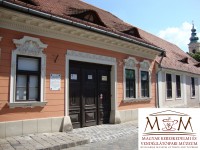Bill slip of Herz Armin’s sons salami factory, with two salami sticks, and illustration of trademark.
The naval entrepreneur, Herz Armin had learnt the secrets of salami production from Italian experts, before establishing a factory in Hungary, in1888. Soon the Hungarian Salami had become a huge success, and won the first prize of Millenium Exhibition in 1896 and the Grand Prix of world’s fair in Paris, 1900. In the 1930’s 400-500 ton of Hungarian Salami had been sold on the foreign markets, which amount multiplied over the years.
en









